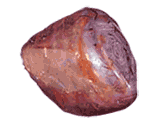| Gemstone Chart |
 Natural Eudialyte Natural Eudialyte
eudialyte is a rare, plummy-red stone. Eudialyte's name comes from the Greek words "eu" and "dialytos", meaning "easy to dissolve" which refers to the mineral's solubility in acids.The stone's distinctive grey, black or white patterning gives each piece of jewelry a unique beauty.
Color: orange red
Categories: semi-precious stone
Crystal Group: Trigonal
Refractive Index: 1.596 - 1.602
Hardness: 5 - 6
Density: 2.88
Occurrence: Sweden; Kippaw,Canada
|  Natural Musgravite Natural Musgravite
Musgravite is an extremely rare member of the taaffeite family that was discovered in 1967 in the Musgrave Range of South Australia. It is also one of rare gemstones that have been sought these years for the collection at GAAJ laboratory.
Color: pale olive green, grey, mauve, grey purple
Categories: semi-precious stone
Chemical Composition: (Fe2+,Zn,Mg)2Al6BeO12
Crystal Group: Hexagonal
Refractive Index: 1.717 - 1.739
Density: 3.68
Occurrence: The Musgrave Mountain Ranges in Central Australia
|  Natural Rhodochrosite Natural Rhodochrosite
Rhodochrosite is a manganese carbonate mineral with chemical composition MnCO3. The pink color of rhodochrosite is caused by the element manganese and it is formed when manganese is dissolved by ground water and combines with a carbonate material and then drips off the ceiling of caves and crevices deep underground.Rhodochrosite often forms pink and white bands. It is often carved into figurines or boxes while the tubular stalactite formations are often sliced for use in jewelry. Fine gem quality crystals are sometimes cut into gemstones for use in high end jewelry, but the more common grade is used extensively in silver and gold jewelry.
Color: Rose red, raspberry red, pink, grey, fawn, brown
Categories: semi-precious stone
Chemical Composition: MnCO3
Crystal Group: Trigonal
Refractive Index: 1.600 ĘC 1.820
Hardness: 4
Density: 3.45 ĘC 3.70
Occurrence: Argentina; Colorado, U.S.A.; Romania; Hungary; India; South Africa; Saxony, Chile; Peru; Mexico.
|  Natural Sillimanite Natural Sillimanite
Sillimanite is an alumino-silicate mineral with the chemical formula Al2SiO5. Sillimanite is a very rare trimorph and it has a common variety called fibrolite.
Color: violet blue, grey green, colorless, brown, green,
Categories: semi-precious stone
Chemical Composition: Al2OSiO4
Crystal Group: Orthorhombic
Refractive Index: 1.658 - 1.678
Hardness: 6 - 7.5
Density: 3.25
Occurrence: France, Madagascar, U.S.A., Sri Lanka, Burma. Kenya
|  Natural Star Sapphire Natural Star Sapphire
A star sapphire is a lovely gem that exhibits a six pointed star because of the intersection of six thin intersecting inclusions. When the gem is lit from above, the inclusions become quite visible and the star shape appears.A powdery grey-blue star sapphire is the centerpiece of a ring from the Art Deco period.
Color: Blue, green blue, violet, blue, black, brown, pink.
Categories: semi-precious stone
Chemical Composition: AL2O3
Crystal Group: Hexagonal
Refractive Index: 1.759-1.778
Hardness: 9
Density: 4
Occurrence: Sri Lanka, Burma, India, East Africa, Ankarana-Madagascar, Thailand.
|
|
